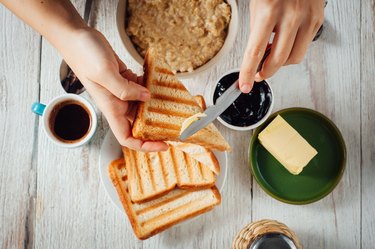
As you age, the approximate proportions of different macronutrients your need stays the same but your total caloric needs decrease. Men between 51 and 70 need 2204 calories per day and after 70 need 2054 calories a day. Women's caloric needs decrease from 1978 calories a day from 51 to 70 to 1873 after 70. As your caloric needs decrease, you need to focus on more nutrient-dense foods, as there is less room to eat junk food and still get all the major nutrients you need without consuming too many total calories.
Protein
Video of the Day
The Recommended Daily Intake, RDA, for protein is 46 grams for women over 50 and 56 grams for men over 50. If you regularly engage in resistance exercise or recovering from certain types of illness or surgery, your health care provider may recommend increasing the amount of protein you consume.
Video of the Day
Carbohydrates
For both men and women over 50, the RDA of carbohydrates is 130 g. Endurance athletes require more carbohydrates than their sedentary peers. If you are training for the master's division of a marathon or triathlon, you'll need more carbohydrates and total calories than a friend who has a sedentary job and does day trading on a computer for recreation.
Sources of Protein
All proteins can be used by your body equally well, but some come packaged with artery-clogging saturated fat and others with fiber. Given your lower caloric needs over 50, you want to focus on sources of lean protein which give important nutrients with minimal calories. The Harvard School of Public Health recommends that you restrict red meats and avoid processed meat, and get your protein from lean poultry, fish, legumes, and moderate amounts of soy products.
Sources of Carbohydrates
In choosing carbohydrates, you want to emphasize sources rich in fiber, vitamins, minerals, and phytochemicals rather than sugary or salty snacks. Choose whole grains, fruits rather than juices, and legumes.